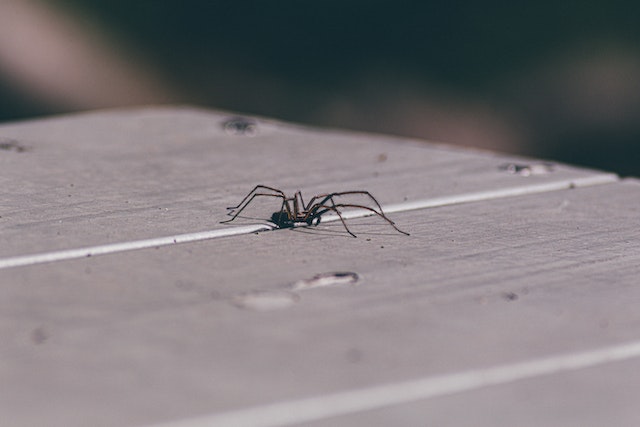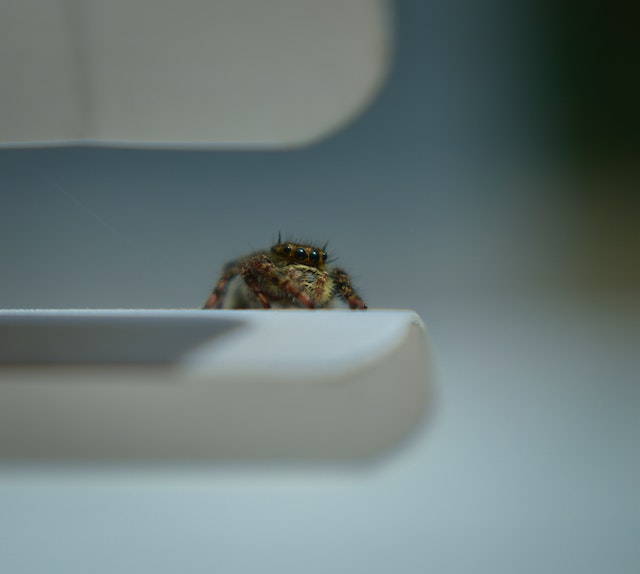Spiders. They’re fascinating creatures that play a crucial role in our ecosystems by helping control insect populations. But when they decide to move into your home uninvited, it can be a bit unnerving.
But how do spiders get in the house anyway?
Take a look at our blog, where we’ll tell you everything you need to know about invading spiders and other species that make themselves home in your humble abode.
How Do Spiders Get in the House?
So, how exactly do these eight-legged arachnids find their way inside your house? Let’s unravel the web of spider intrusion and explore the most common routes they take to infiltrate your living space.

Open Doors and Windows
The simplest and most common way spiders enter your home is through open doors and windows. Spiders are adept climbers and can quickly scale walls and screens. So, when you leave doors and windows open, you’re essentially rolling out the welcome mat for these creepy crawlers.
To prevent this, repair any torn window screens and use door sweeps to seal gaps at the base of doors. Additionally, consider installing fine-mesh screens that can help keep even the tiniest spiders out.
Gaps and Cracks in Walls
Spiders are opportunistic creatures, always looking for small openings that lead to cozy hiding spots. Gaps and cracks in your home’s walls, especially near windows and doors, provide an easy entry point for them. Even a tiny crack can accommodate a spider, as their bodies are incredibly flexible.
Regularly inspect the exterior of your home for cracks, gaps, and holes. Seal them with caulk or weatherstripping to block potential spider entrances. Remember, it’s not just about keeping out the big ones; it’s also about preventing spiderlings from making their way in.
Vents and Chimneys
Vents and chimneys offer another pathway for spiders to enter your home. These openings can particularly appeal to some species of spiders that prefer dark, dry environments. To prevent spiders from using vents and chimneys as entry points:
- Install vent covers or screens to block access.
- Have your chimney inspected and sealed if necessary.
- Ensure that bathroom and kitchen exhaust fans are vented outdoors and not just into your attic, as this can attract spiders seeking moisture.
Vegetation and Overhanging Trees
If trees or shrubs are near your home, you might inadvertently invite spiders indoors. Some spiders, like the orb-weaver, are known for building intricate webs in trees and bushes. When these webs get too close to your home, it becomes easier for spiders to leap over your walls or windows.
Trim back branches and foliage that touch or hang over your house. This prevents spiders from using them as bridges and helps deter insects that might attract spiders in the first place.
Outdoor Clutter
Messy outdoor areas can become a spider haven. Piles of firewood, leaf litter, and outdoor clutter create ideal hiding spots for spiders and their prey. When they feel threatened or when conditions become unfavorable outside, spiders may seek refuge indoors.
Keep outdoor areas tidy and organized. Store firewood away from your home, clear debris, and consider using outdoor lighting to deter spiders and their insect prey.
Hitchhiking
Spiders are tiny hitchhikers. They might not intentionally invade your space but can hitch a ride on items you bring indoors. This can include potted plants, outdoor furniture, clothing, and shoes.
Before bringing outdoor items inside, give them a good shake or inspection to ensure no spiders are clinging to them. Shake out your clothing and shoes, especially when left outside.
Through Other Insects
Spiders are opportunistic predators, and they follow their prey. If you have a problem with other insects inside your home, spiders may follow them in search of a meal. Common household insects like flies, mosquitoes, and ants can draw spiders indoors.
Address any insect infestations promptly to reduce the spider’s food supply. You can also use insect screens on windows and doors to keep out insects and the arachnid predators following them.
What About House Spiders?
How do spiders get in the house if their primary habitat is your home?
House spiders, domestic house spiders, or Parasteatoda tepidariorum, are uniquely adapted to indoor living. Their primary habitat often becomes our very own homes. But how do they find their way in?
Egg Sac Arrival:
House spiders are sneaky hitchhikers. They typically enter homes through tiny, inconspicuous egg sacs that can be carried inside on various objects. These egg sacs are incredibly resilient, capable of surviving harsh conditions, and serve as the initial gateway for house spiders.
Maternal Protection:
Once inside a house, the story continues. The mother spider strategically places egg sacs in hidden, sheltered spots within your home, such as basements, attics, crawlspaces, or wall voids. When the spiderlings hatch, they spend some time near the egg sac and then gradually disperse throughout the house.
Dispersal:
As the spiderlings grow and mature, they venture out within your home. Their remarkable climbing skills allow them to navigate small openings, gaps, and crevices in walls and ceilings. They might also hitch rides on objects moving around the house, like clothes or personal belongings.
Middletown, NY, Spider Control
Curious about how to keep your Middletown, NY, home spider-free and pest-safe? Look no further than United States Pest Service!
Our expert team specializes in comprehensive pest control solutions tailored to your needs. Say goodbye to unwanted houseguests and enjoy a pest-free living space. Contact us today to schedule a consultation and discover how we can help safeguard your home.

